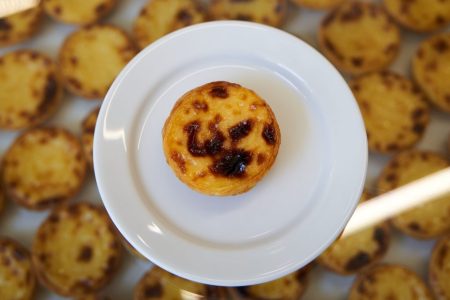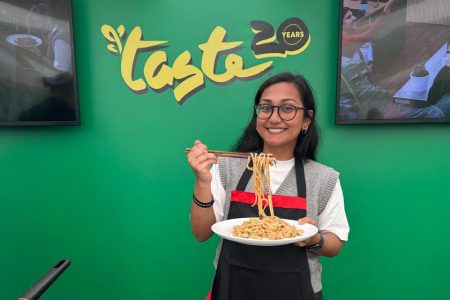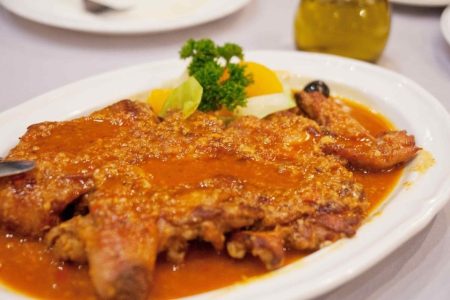For people from the Philippines, no place feels more like home in Macao than the narrow and busy Rua da Alfândega. The street is just 3 minutes from Macao’s landmark Senado Square and has everything they could need – from Pinoy convenience stores and hair salons to several eateries. Small wonder the street is simply nicknamed “Philippine Street” or “Pinoy Street.”
Who better to share the top Filipino food picks around the area than Ari Calangi? The Macao-born Filipino musician has been busy this year, touring with K-pop artist Henry Lau – assisting in handling stage, sound, and music logistics for all of Lau’s performances. After an enforced hiatus during the Covid-19 pandemic, Calangi is currently focused on rebuilding his network in the industry and collaborating with different artists.
Growing up in Macao, Calangi has a deeper connection with the local cuisine than he does with Philippine cuisine. But he says that attending events with family and friends has helped him understand more about Filipino food and culture.
“Whether it was celebrating a birthday, gathering after Sunday mass, or enjoying a casual barbecue in Hac Sa, the inclusiveness of Filipino culture and food or drink was always there,” says Calangi.
[See more: Ari Calangi: Making his return to the stage]
Spicing up Filipino dishes at home was Calangi’s mother, Shelley Grace Calangi. She raised three children and exposed them to various types of music. Besides being musically inclined, she is also a great cook. One of Ari’s favourite home-cooked dish is her adobong pusit (squid cooked in the classic adobo style with garlic, vinegar, and squid ink). “Mom would make it whenever she felt like it, and it was a nice surprise,” he says.
Unlike his mother, Calangi says he’s not suited for the kitchen. But he knows a good meal when he has one. Calangi took time off his busy schedule and walked Macao News through his favourite Filipino eateries around Rua da Alfândega.
Anak Bakery
What’s the best thing you can buy in Macao for one pataca? Easy. It’s the popular pandesal – a traditional Philippine bread roll – at Anak Bakery, where its price has gone unchanged since the bakery opened in 2003. The ube cheese pandesal is another must-try roll and costs five patacas.
The store has brought joy to many Filipinos in the SAR. Calangi is one of the many. He recalls how his mother’s friends often brought pandesal from the Philippines, hand-carrying it back as “pasalubong” (souvenirs) every six months to a year. “I remember the excitement when the Anak opened its doors,” Calangi says. “We finally had a comparatively steady supply of pandesal.”
Calangi explains that the roll goes well with mostly anything; jam, butter, meats, coffee – and even Milo. “If you know, you know, ” he says with a smile.
DC Cafe
The famous DC Cafe is within a minute’s walk from Anak and has been around for the last five years. The restaurant is run by husband and wife duo, Dennis Coronado and Marissa Javilonar. Coronado helps manage the business, while Javilonar serves her delicious Filipino dishes.
Coronado told Macao News that the restaurant’s prices have never been too high. “We want Filipinos who don’t get paid much, to be able to afford their hometown cravings,” he says. They even keep the restaurant open until 2 am for those who finish work late.
There are many popular Pinoy dishes to choose from here. For Calangi, it’s Marissa’s Chicken Cordon Bleu. He describes it as “ham wrapped in chicken, looking like a rolled-up deep-fried meat towel, all smothered in a creamy cheesy sauce.”
The restaurant is also well known for its grilled meats or seafood with rice, served on a banana leaf, which is eaten by hand. If you’re a dessert fan, you have to try the halo-halo – a concoction of ube ice cream, ube, caramel pudding, milk, jellies, sugar palm and red beans.
Giro Pizza
According to Calangi, if you’re looking for a delicious midnight snack – Giro Pizza is the place to go. Not for the pizzas, however, but for the barbecued Filipino snacks.
As a musician, Calangi often works on late-night recordings. Giro’s is a secret weapon that fuels him through an overnight session.
[See more: On parade: Macao’s Philippine community celebrates the Sinulog Festival]
“The proper way to enjoy Filipino-style barbecue is to dip it in a mix of vinegar and soy sauce, and toss in some chilis if you want a kick,” he says.
Some Calangi’s Giro Pizza recommendations are the chicken and pork barbeccue with the sauces mentioned above. Other Filipino delicacies available are Philippine hotdogs, pork liver, pork liempo (pork belly), chicken inasal, beef steak, lumpia (spring rolls) and kwek kwek (hard-boiled egg covered in batter).
Jollibee
Founded in 1975, Jollibee has become one of the leading fast-food chains with over 1,500 stores worldwide. Macao opened its first in 2018 and drew many customers. Today, the SAR has four branches.
As a child, Calangi first tried Jollibee’s popular crispy fried chicken in the Philippines. He liked it, but not as much as he does the Jolly Spaghetti.
[See more: Jollibee to open 4th Macao store in Hac Sa Wan]
“The spaghetti caught me off guard,” he says. “The secret ingredient? Banana Ketchup! It sounds weird but it’s sweet, sour, and worth the hype!”



